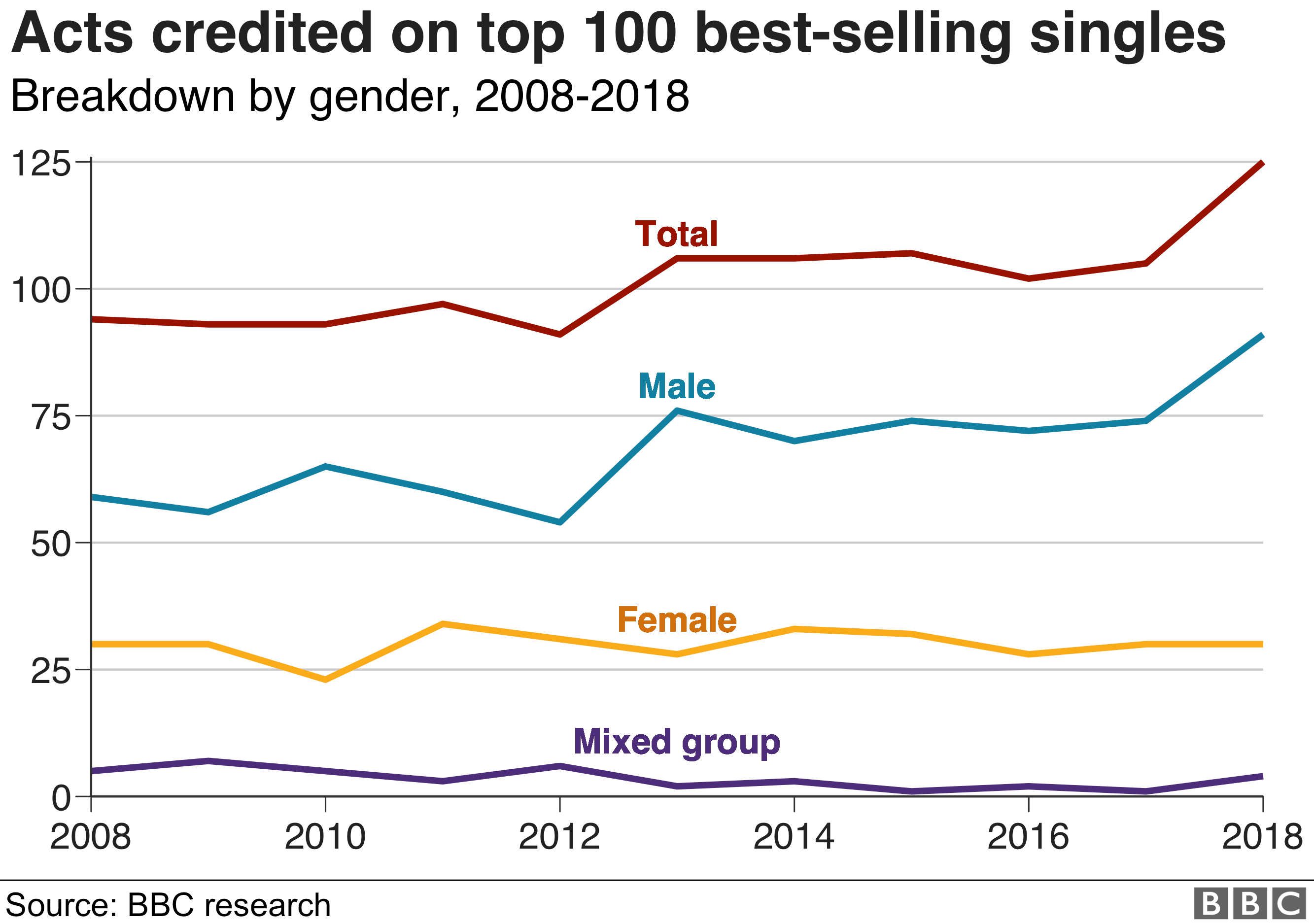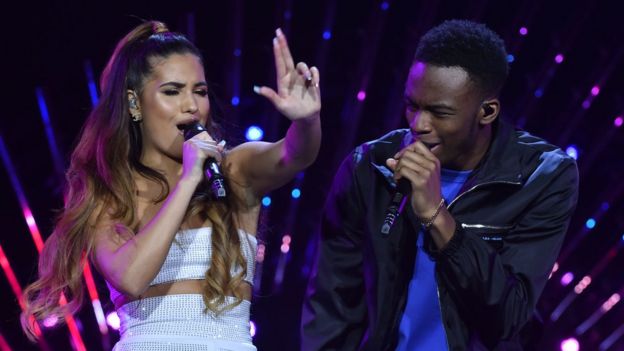
Three times as many male as female pop stars appeared on last year's biggest hit singles, BBC research has found.
Ninety-one men or all-male groups were credited on the Official Chart Company's top 100 most popular songs of 2018 - compared with 30 female acts.
And despite the success of singers like Dua Lipa and Ariana Grande, the gender gap has grown over the past decade.
Thirteen of the most popular 100 songs of 2018 were credited only to female acts - down from 35 in 2008.
Singer Mabel, who is currently in the top 10, said she wasn't surprised by the gender gap, telling BBC News: "No, I think we still have a lot of work to do."
Rita Ora and Bebe Rexha's manager Sarah Stennett said: "The gap that exists is not acceptable. I do not believe the consumer says, 'I want to listen to more men than women'. It's the choice they're given."
Yes and no.
Dua Lipa, Kacey Musgraves, Cardi B and Lady Gaga took the limelight and many of the top prizes at the Grammy Awards last weekend.
On Friday, Ariana Grande became the first female artist in UK singles chart history to replace herself at number one.
And women like Dua, Anne-Marie and Jorja Smith dominate the nominations for the Brit Awards, which will be handed out on Wednesday.
There are no fewer women in the UK charts now than there were a decade ago - in 2008, 30 female acts were credited on the best-selling 100 songs of the year. In 2018, the figure was still 30.
But the number of men has risen by more than 50% as the number of collaborations has grown over that time - from 59 men in 2008 to 91 in 2018. Which means the gender gap has grown.

It's become much more common for hit songs to be collaborations - Pop Star A "featuring" Pop Star B.
That means the total number of artists credited on songs in the end-of-year top 100 list has risen over the past decade.
You might have expected the number of men and women to have risen equally, but no. Only the number of male acts has risen.
In 2008, stars like Alexandra Burke, Duffy and Katy Perry were among the 35 female acts to have hit singles on their own.
Last year, that number was 13, including Dua, Ariana and Anne-Marie as well as Jess Glynne, Loren Allred and Rita Ora.
At the same time, the number of songs credited to both a female and a male act has risen from 10 to 25.

So songs by a man AND a woman have replaced many of those that were JUST credited to a single female act a decade ago.
Meanwhile, men are also collaborating more with other men - hence the steep rise in the overall number of male acts appearing on the top 100 singles.
But women are largely not collaborating with other women - or if they are, those songs aren't as popular. None of the top 100 songs of 2018 were collaborations just between female-only acts. But there's no change there - that was the same in 2008.
There's always been a gender imbalance in pop music - just think about the genders of the biggest stars of the past 60 years.
Part of the reason collaborations are now more common is because it's a good way for one act to get exposure with the fans of another - especially in the streaming age, when it's harder to break through. Often the other artist will be from a different genre.
And these days, the charts are dominated by dance and rap - which are both overwhelmingly male - at the expense of traditional pop, singer-songwriters and girl groups.
Dance music often has female vocalists, but the DJs/producers/hitmakers who they appear with - people like Calvin Harris, Marshmello, David Guetta, Zedd, Jax Jones - are almost always men.
In rap, Cardi B may have broken the glass ceiling but she is still far outnumbered by the likes of Drake, Post Malone, Macklemore, Kendrick Lamar and French Montana.

Fine Line by Mabel (featuring Not3s) was the 70th best-selling single of 2018
Singer Mabel, who had a hit last year with Fine Line (featuring Not3s) and is now in the charts on her own with Don't Call Me Up, says she is "very aware of the fact there's a long way to go".
She explains: "I think it's about encouraging young female artists, to give them the space to experiment. I think that's the issue.
"As women, we get moulded in to something that we don't necessarily want to be, whereas as a boy I think you're encouraged to just sort of figure it out [and] do whatever you want to do. I think it's just about encouraging the younger generations to have fun with it."
Soul superstar John Legend said: "That's surprising when you have people like Adele, Taylor Swift, Selena Gomez, Ariana Grande - women who I think of as the biggest things in music right now.
"But I guess if you count those DJs [eg Calvin Harris and DJ Khaled], it's a little different because the voices people are hearing are women, even though it's the DJ's record.
"It's also probably a product of hip-hop being predominantly male, because hip-hop is such an important part of music, and 95% of popular hip-hop artists are men."

Sarah Stennett (second left) with singers Nicola Roberts, Bebe Rexha, Rita Ora, Kara Marni and RAY BLK at a Women In Harmony dinner
Sarah Stennett, who runs First Access Entertainment, says she isn't surprised by the figures, and thinks a lot of it is down to the "gatekeepers" - the people who decide what gets promoted on streaming platforms, on the radio and at festivals.
They aren't sexist as individuals, but there is a "systemic" problem, she believes.
"To underestimate the challenge that these women have to make music would be a disservice to them, because they walk into rooms to make records with men. Everything that happens in a boardroom - 'You're crazy, you're on your period' - happens in a creative space, too."
Collaborations are healthy, as long as it's an equal partnership and women aren't always relegated to being the featured artist, she adds.
"If you try and redress the balance as an industry - because women are every bit as creative and brilliant - then it will be redressed, but it has to be a conscious effort by everybody."
"It's not really surprising that the number of artists has gone up, but it does seem counterintuitive that that should be so male-dominated," says Music Week magazine editor Mark Sutherland.
"If you feature more people on your record, the idea is that fans of that person are more likely to play it and get into it and repeat play it, and it crosses you over to different audiences in a way that's quite hard to do in a more streaming-orientated business.
"Generally, you don't want to pick an artist with a similar fanbase to yours because you're just reaching the same people, and a lot of featured artists are rappers, so maybe female pop artists are putting rappers on their records to reach a new audience, and vice versa. But maybe it's less prevalent the other way around."
Lara Baker, a music industry diversity consultant, says there has long been a gender imbalance in the charts and behind the scenes, but adds that the figures showing a growing gap are "really worrying".
"I'd like to see streaming platforms, festivals and radio stations giving more attention to equal representation than they currently do," she says.
"If you look at any of the major streaming playlists, or a radio station's playlist, or a festival line-up on any given day - chances are in many cases you'll find male artists taking up more slots than female artists.
"They might argue that they're reflecting the market and what the consumer or listener wants, but are they? Or are they part of the problem that causes this imbalance? We all have our part to play in building a more equal music business."
She adds: "There is no lack of appetite and lack of talent when it comes to women writing and making music, so clearly what we do have is an old-fashioned and biased industry which needs to work together to achieve better gender balance."
The BPI, which represents the UK's recorded music industry, said: "Solo female credits may have been responsible for just 13 of the top 100, but, if you broaden the definition a little, female artists were the lead, or co-credited artists on a further 17 songs, while there were additional songs, including three Clean Bandit tracks and others, where women are featured."